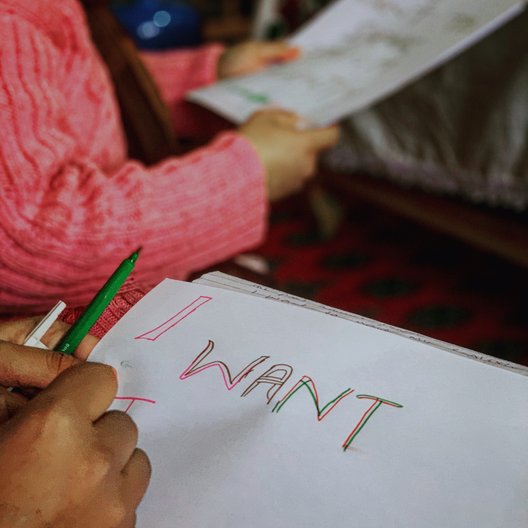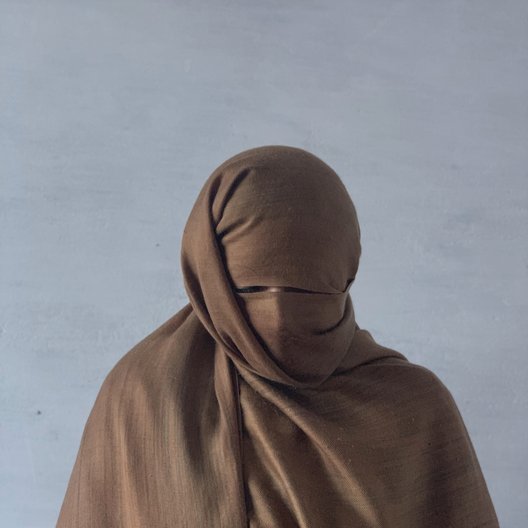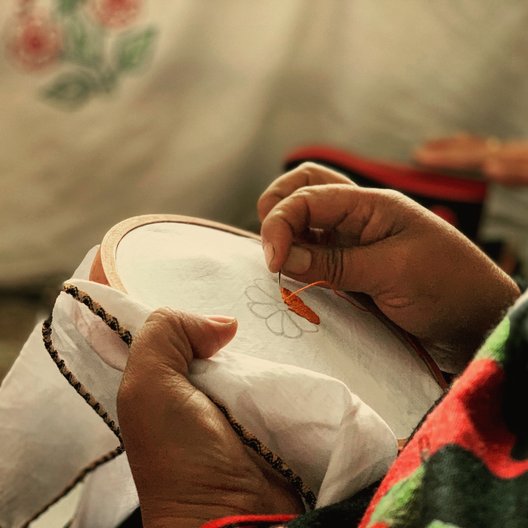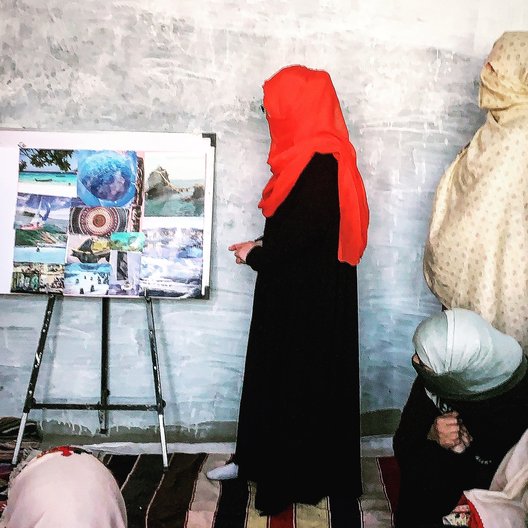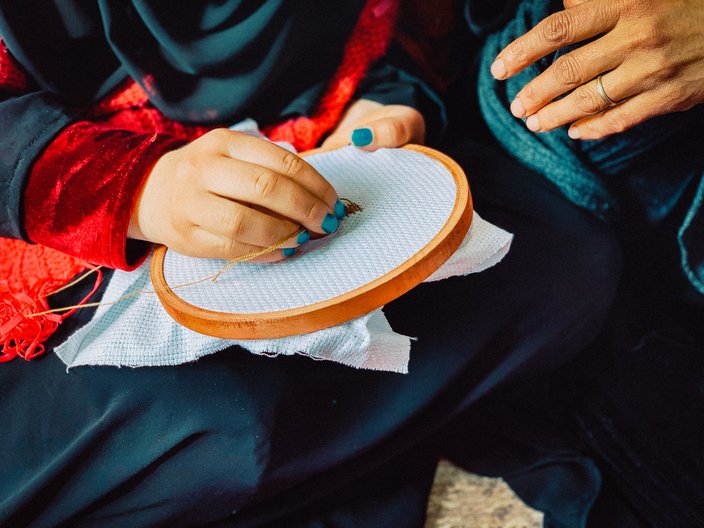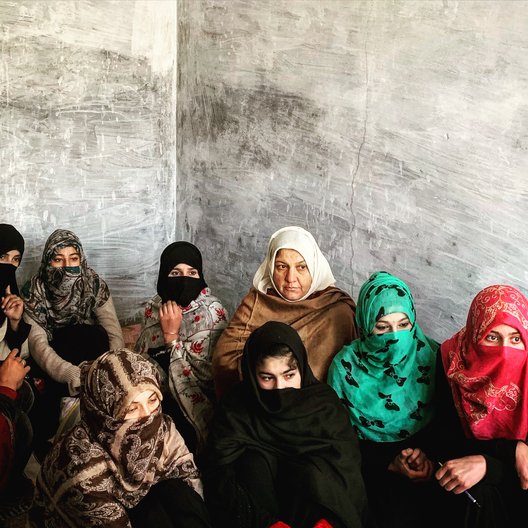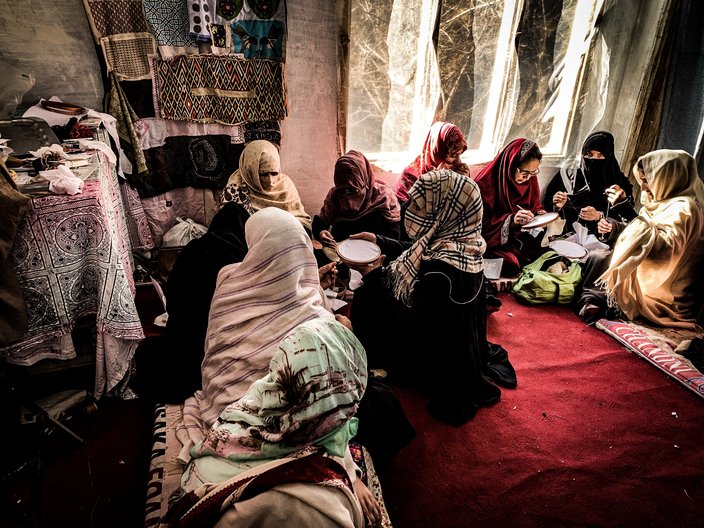25 November 2019
by Adil Iqbal
Designer Adil Iqbal was selected for one of Crafting Futures grants in 2018. He travelled to Chitral in Pakistan, where he explored how you can sustain embroidery in a community where matters around social isolation and mental health are not being adressed.
He tells us more about his research and what he discovered. You can also have a look at what Adil learned through his video output here.
I am a Scottish Pakistani artist and currently run a community-led initiative ‘ Twilling Tweeds’, which work with grassroot artisan communities. I use interdisciplinary methods, such as embroidery, visual anthropology and collaborative learning and constantly looking for new ways to connect my work with diverse communities.
Last December I spent two weeks in Chitral, Northern Pakistan as part of the British Council Crafting Futures programme. The aim of the project was to initiate a 'craft community collaboration' between groups of senior women embroiderers and young teenage girls. The project specifically addressed the declining youth engagement with hand embroidery as well as the growing intergenerational divide. I conducted a series of contemporary Textile Design and embroidery workshops in partnership with a local women's collective (Kho and Kalashi).
During the workshops I interacted with two different communities, one was from Dolomoch Dastkari Centre (DDC), and the other was in Zargarandeh, Chitral town. The tutorials focused on interactive sessions on the design process and touched on themes around inspiration and concept development. Needlework based training was given by senior artisans to young girls with the aim to increase fine hand skills, as well as bridging the gap between the generations.
Although I have been working with craft communities in Chitral for over 8 years and undertaken numerous creative projects, I was never able to work closely with the younger generation. Designers on many occasions failed to recognise the social issues affecting craft communities and are often pressured into the demands of globalisation. I believe, to sustain any craft, it is important to understand the social challenges that are faced by the artisans.
The dynamics of traditional Chitrali families are restrictive, specifically to the female gender. Women in Chitral have access to social media and the wider world but are in a society where the frustrations of limited access to work and training provide a hotbed of mental health issues. There is limited access for women to take up professional training in creative arts and business development as the current education system is geared towards the sciences, medicine and engineering. This has led to many young girls failing their examinations and causing high levels of anxiety and depression. The remote location of Chitral further isolates them with insufficient training opportunities, which has resulted in many women sitting idly at home. Suicide rates among young women in Chitral have dramatically increased in recent years, with recent reports suggesting that 68% of the suicides were unmarried women.
How can you sustain embroidery within a community when matters around social isolation and mental health are not being addressed?
In Chitrali society, the concept of the ‘skilled hands’ has always enjoyed a high status. In particular, women skilled in handicrafts have been held in high regards. Many young girls today in Chitral are interested in learning design and improving their embroidery skills. Unfortunately, due to changing social and familial pressures on girls to pursue certain types of education and careers, this is not encouraged by the wider community. The limited access to good quality design and craft education has resulted in the youth perceiving crafts like weaving and embroidery as a domestic activity, practised by their mothers and grandmothers. For instance, Chital is famous for producing ‘shu’ (hand-woven woollen cloth) but it has started losing ground to larger industrial materials from China. Hence, there is an urgency to mobilise the youth and provide a creative learning environment, which will enable them to consider careers in the arts.
The British Council provided me with the opportunity to develop a deeper insight into women’s lives and highlighted the main causes behind limited access to education and work opportunities. Specifically for the first time, I worked with groups of women who came from a marginalised and low-income background. Their stories made me realise how these issues were intrinsically tied to the future of hand embroidery.
This experience has expanded my knowledge of Chitrali craft traditions, as well as finding tangible solutions to the problems affecting women. One of the solutions is to develop a community training hub, running a variety of creative educational workshops, apprentice style training opportunities and mentoring in skills and personal development. Additionally, as a male designer, I was able to break down gender barriers. This helped create a unique space for my work within a conservative culture where the majority of women observe purdah.
By the end of the workshops, focus group discussions were organised and feedback on individual projects was given to all the participants. The women were able to confidently articulate their opinions, gained a high level of self-esteem in their creative ability and forged a relationship with each other.
Since returning from Chitral, I have collaborated with a Scottish based Social Enterprise ‘Kilcheran’ to develop a community Centre in Chitral. The project Mahraka, which means a gathering of people will be a unique space in Chitral which aims to strengthen local women’s connectivity, confidence and mental wellbeing. The project launched its fundraiser this month. Further details can be found here: www.twillingweeds.com/mahraka
In the future, I am exploring a new community-led initiative to be launched between Scottish makers and weavers from Chitral. In addition I am preparing to write a book on the work I carried out through Twilling Tweeds and Hunarmand Hoost (Skilled Hands).
Follow Twilling Tweeds on Instagram and Facebook
